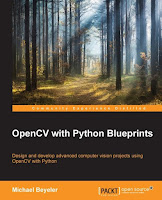OpenCV with Python Blueprints
This repository contains all up-to-date source code for the following book:
Michael Beyeler[**OpenCV with Python Blueprints: Design and develop advanced computer vision projects using OpenCV with Python**](http://www.amazon.com/OpenCV-Python-Blueprints-Michael-Beyeler/dp/1785282697)
Packt Publishing Ltd., London, England
Paperback: 230 pages
ISBN 978-178528269-0
All code was tested with OpenCV 2.4.9 and Python 2.7 on Ubuntu 14.04 and Windows 8.1, and is available from: https://github.com/mbeyeler/opencv-python-blueprints.
For questions, discussions, and more detailed help please refer to the Google group: https://groups.google.com/d/forum/opencv-python-blueprints
Critical Reception
What readers on Amazon have to say:
The author does a great job explaining the concepts needed to understand what's happening in the application without the need of going into too many details.
– Sebastian Montabone
Solid and useful book on getting ramped up with OpenCV in Python. I have found it useful several times in the recent weeks as I am exploring OpenCV.
– bigbirdtommy
Usually I'm not a big fan of technical books because they are too dull, but this one is written in an engaging manner with a few dry jokes here and there. Can only recommend!
– lakesouth
Software Requirements
All projects can run on Windows, Mac, or Linux, and require the following software packages:
- OpenCV 2.4.9 or later: Recent 32-bit and 64-bit versions as well as installation instructions are available at http://opencv.org/downloads.html. Platform-specific installation instructions can be found at http://docs.opencv.org/doc/tutorials/introduction/table_of_content_introduction/table_of_content_introduction.html.
- Python 2.7 or later: Recent 32-bit and 64-bit installers are available at https://www.python.org/downloads. The installation instructions can be found at https://wiki.python.org/moin/BeginnersGuide/Download.
- NumPy 1.9.2 or later: This package for scientific computing officially comes in 32-bit format only, and can be obtained from http://www.scipy.org/scipylib/download.html. The installation instructions can be found at http://www.scipy.org/scipylib/building/index.html#building.
- wxPython 2.8 or later: This GUI programming toolkit can be obtained from http://www.wxpython.org/download.php. Its installation instructions are given at http://wxpython.org/builddoc.php.
In addition, some chapters require the following free Python modules:
- SciPy 0.16.0 or later (Chapter 1): This scientific Python library officially comes in 32-bit only, and can be obtained from http://www.scipy.org/scipylib/download.html. The installation instructions can be found at http://www.scipy.org/scipylib/building/index.html#building.
- matplotlib 1.4.3 or later (Chapters 4 to 7): This 2D plotting library can be obtained from http://matplotlib.org/downloads.html. Its installation instructions can be found by going to http://matplotlib.org/faq/installing_faq.html#how-to-install.
- libfreenect 0.5.2 or later (Chapter 2): The libfreenect module by the OpenKinect project (http://www.openkinect.org) provides drivers and libraries for the Microsoft Kinect hardware, and can be obtained from https://github.com/OpenKinect/libfreenect. Its installation instructions can be found at http://openkinect.org/wiki/Getting_Started.
Furthermore, the use of iPython (http://ipython.org/install.html) is highly recommended as it provides a flexible, interactive console interface.
License
The software is released under the GNU General Public License (GPL), which is the most commonly used free software license according to Wikipedia. GPL allows for commercial use, distribution, modification, patent use, and private use.
The GPL is a copyleft license, which means that derived works can only be distributed under the same license terms. For more information, please see the license file.

